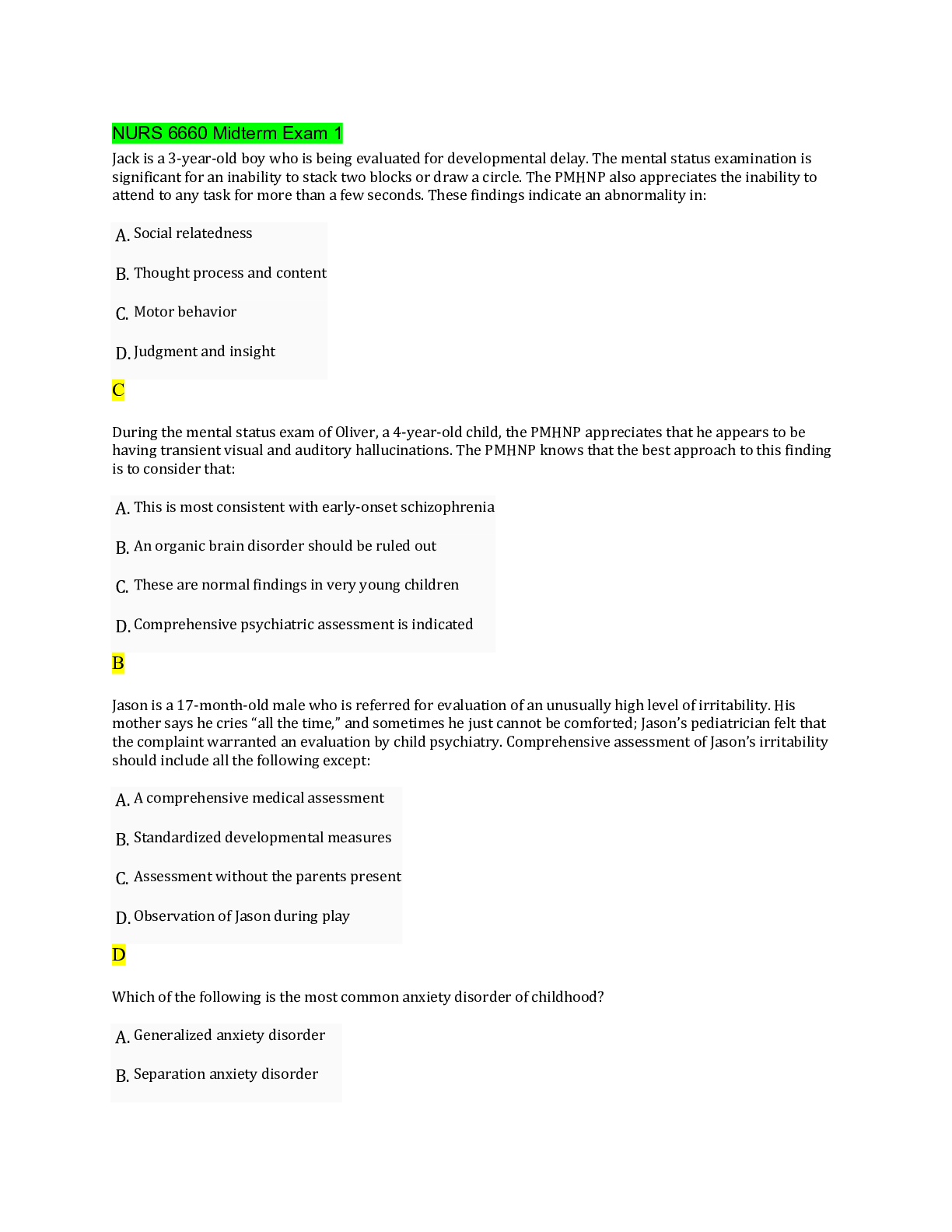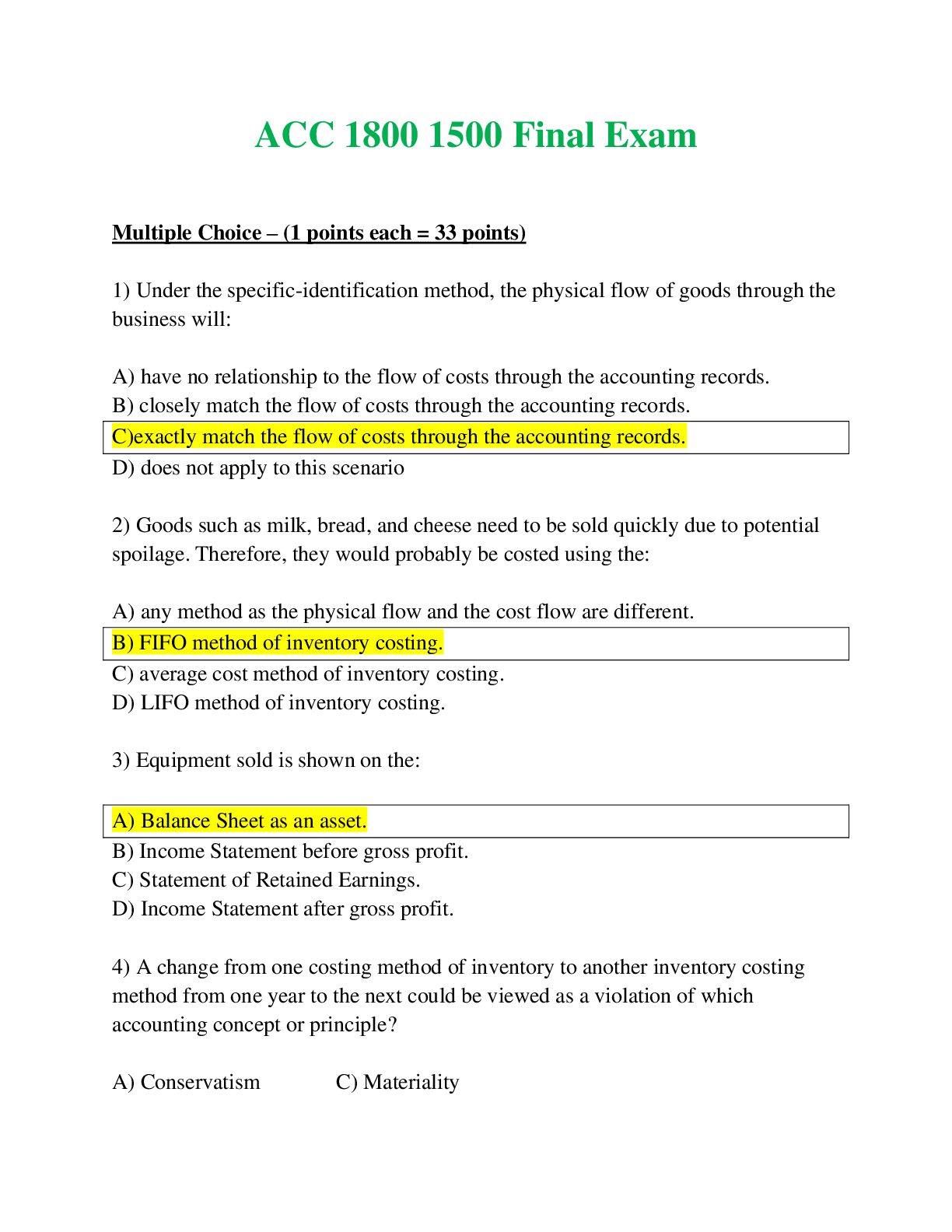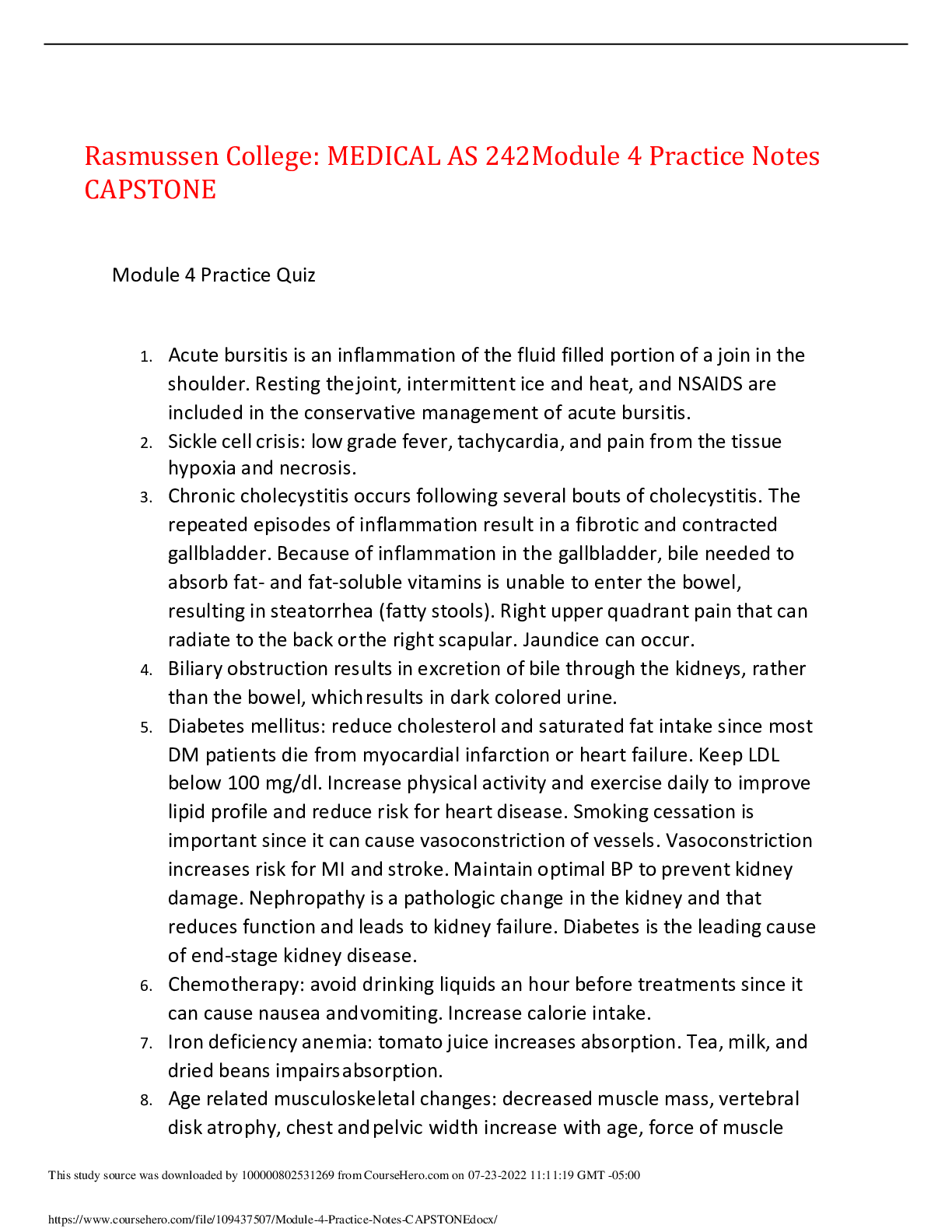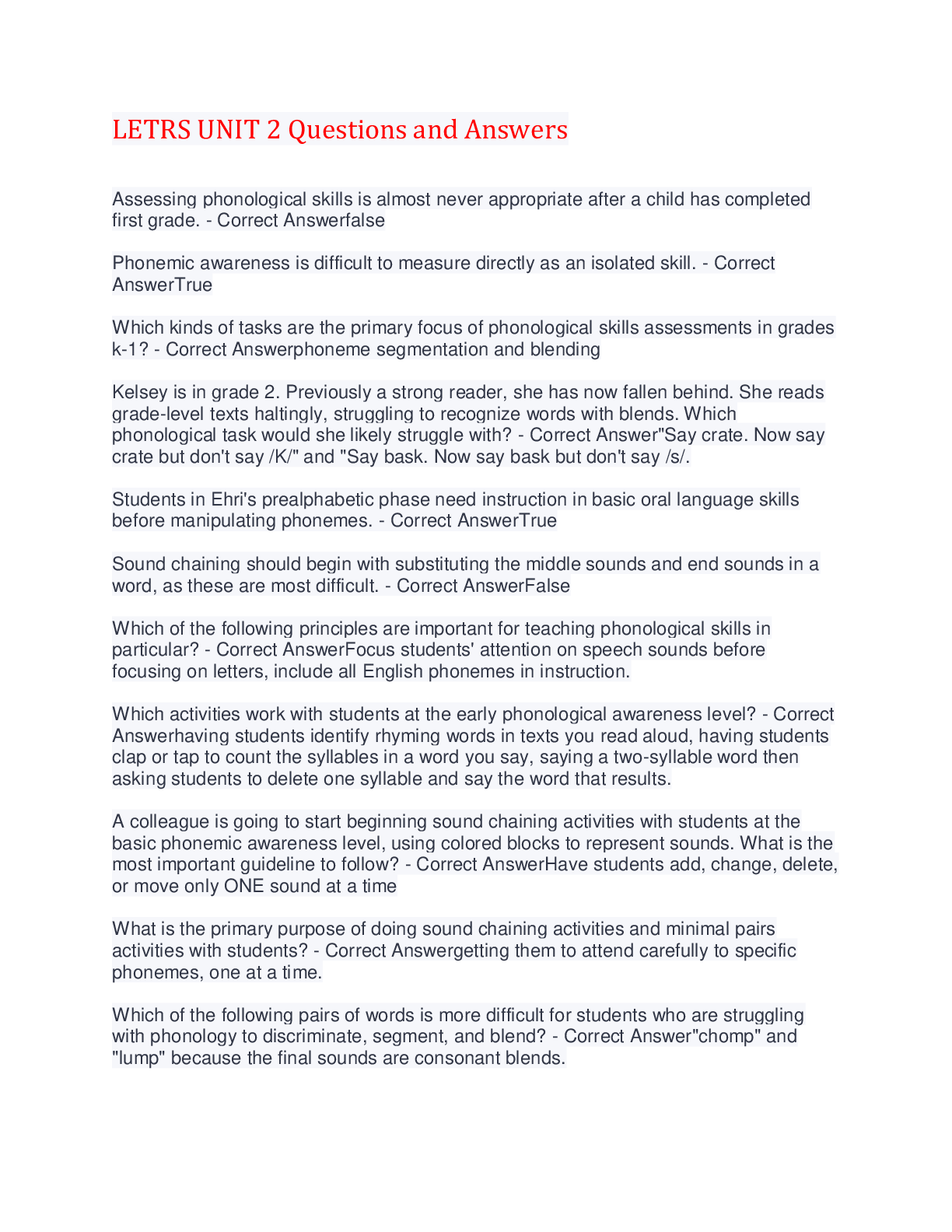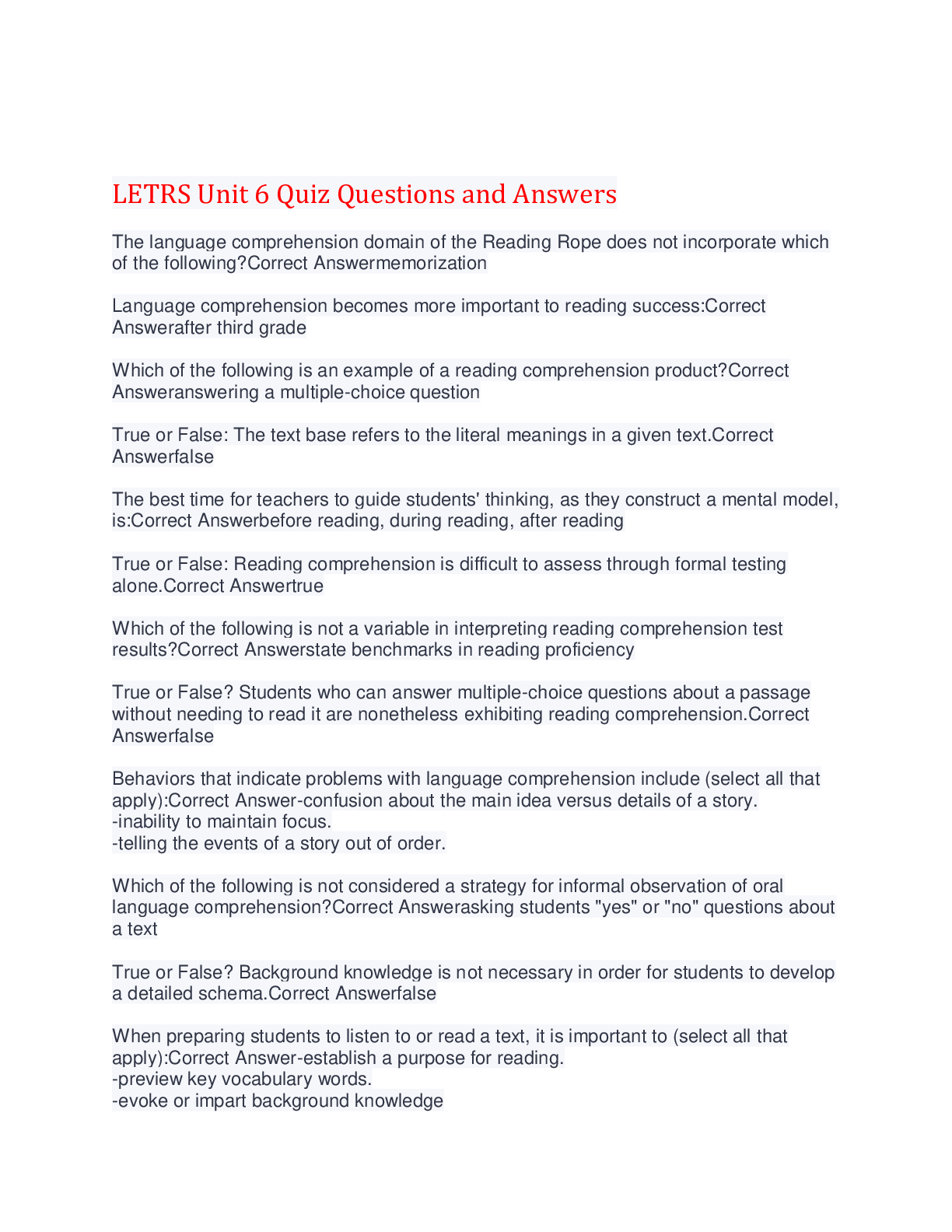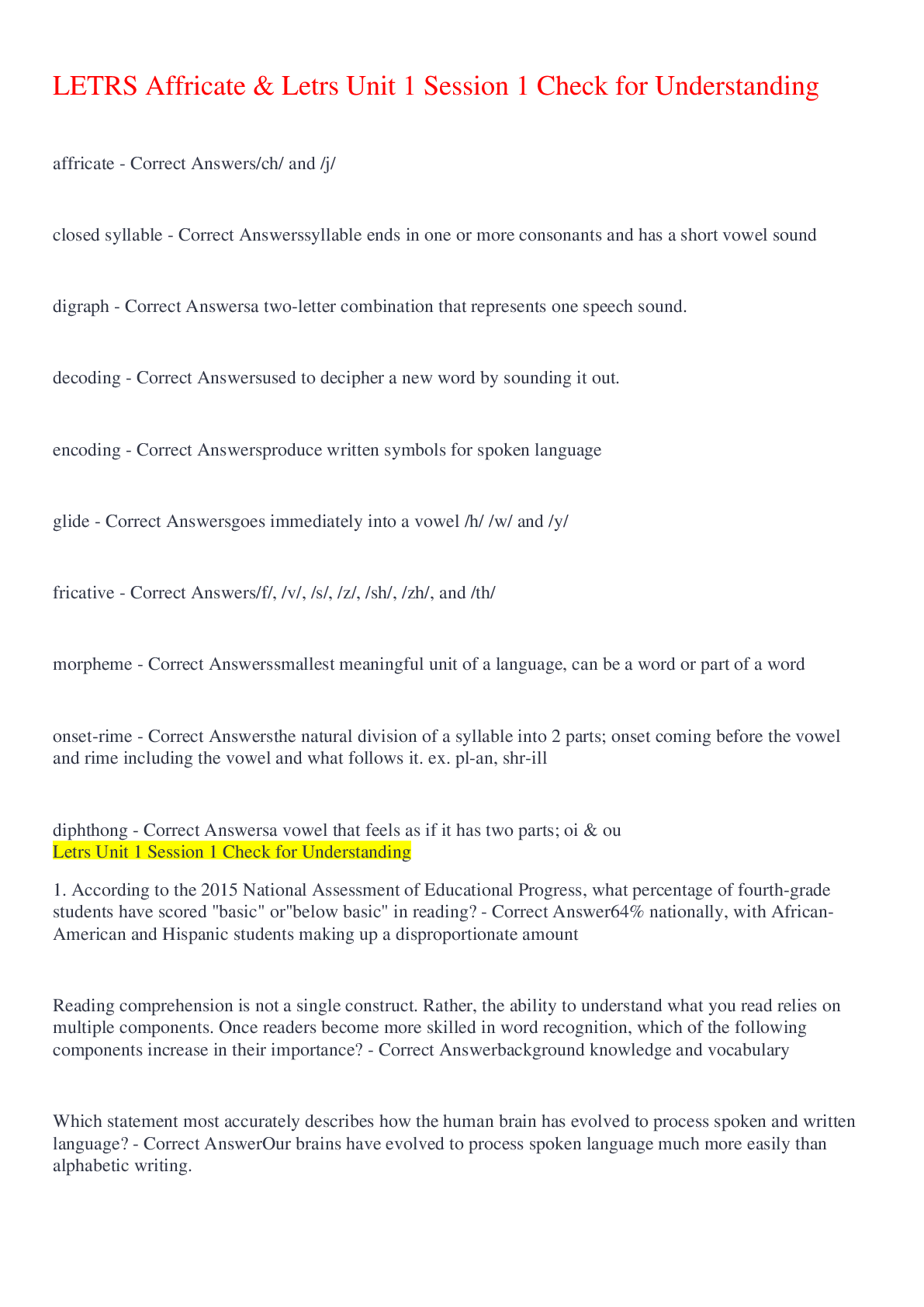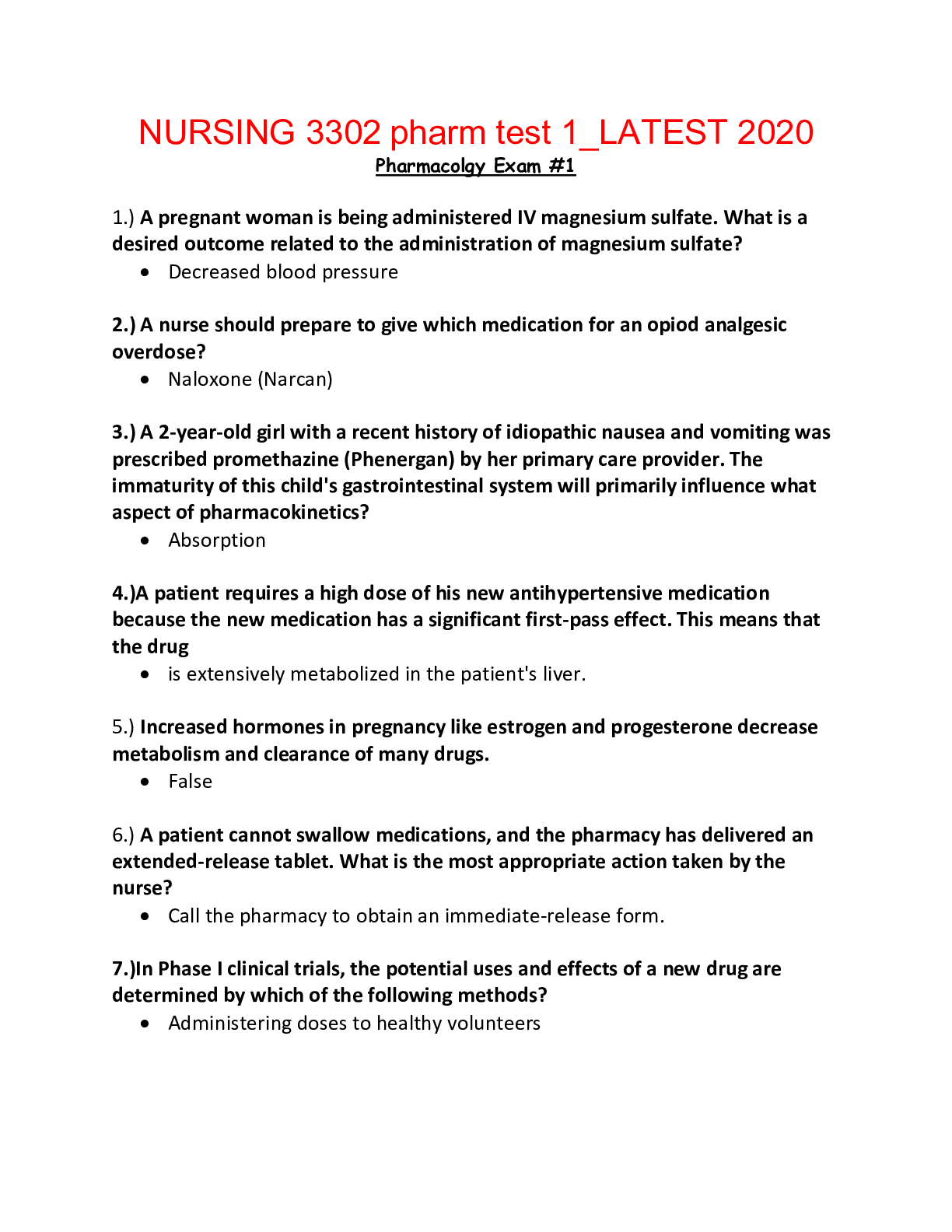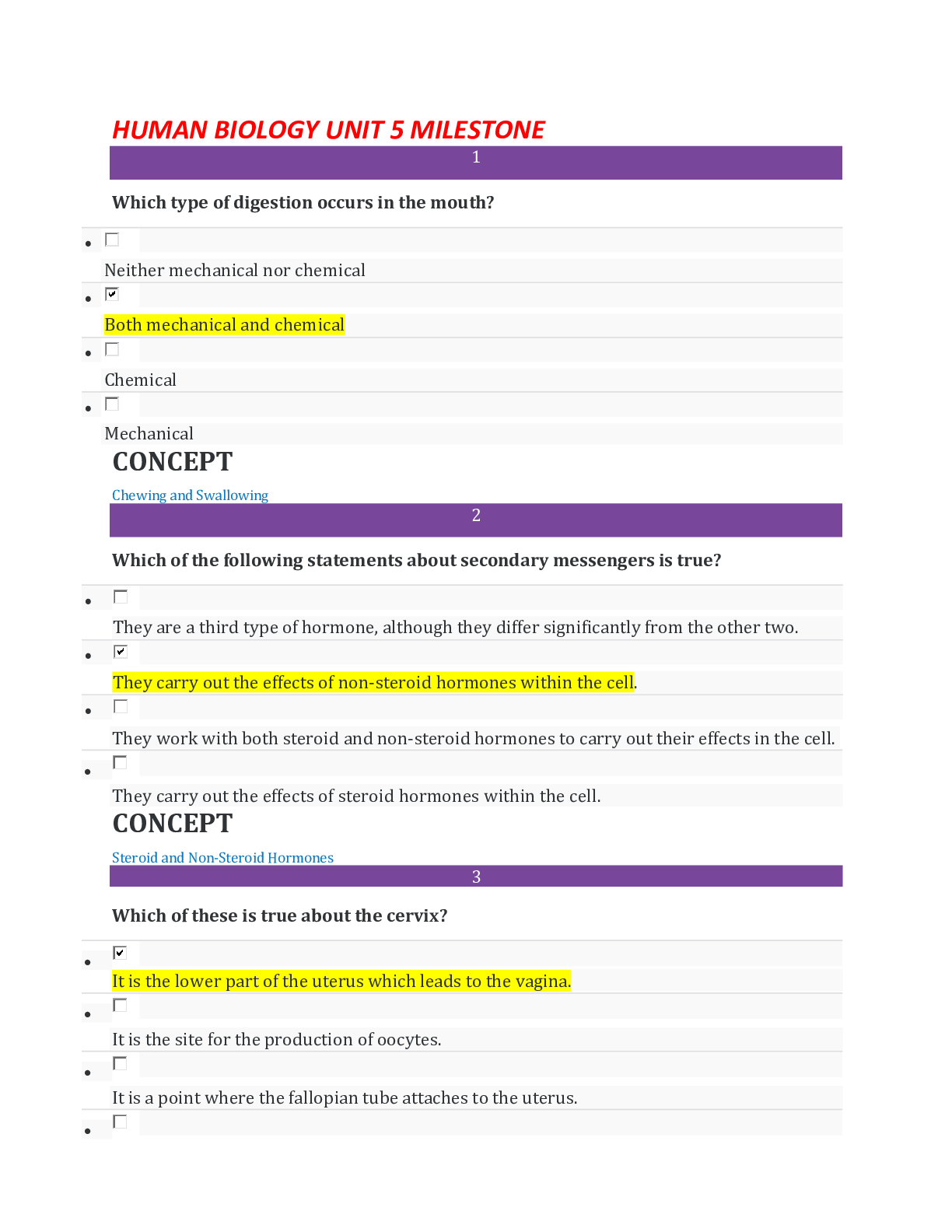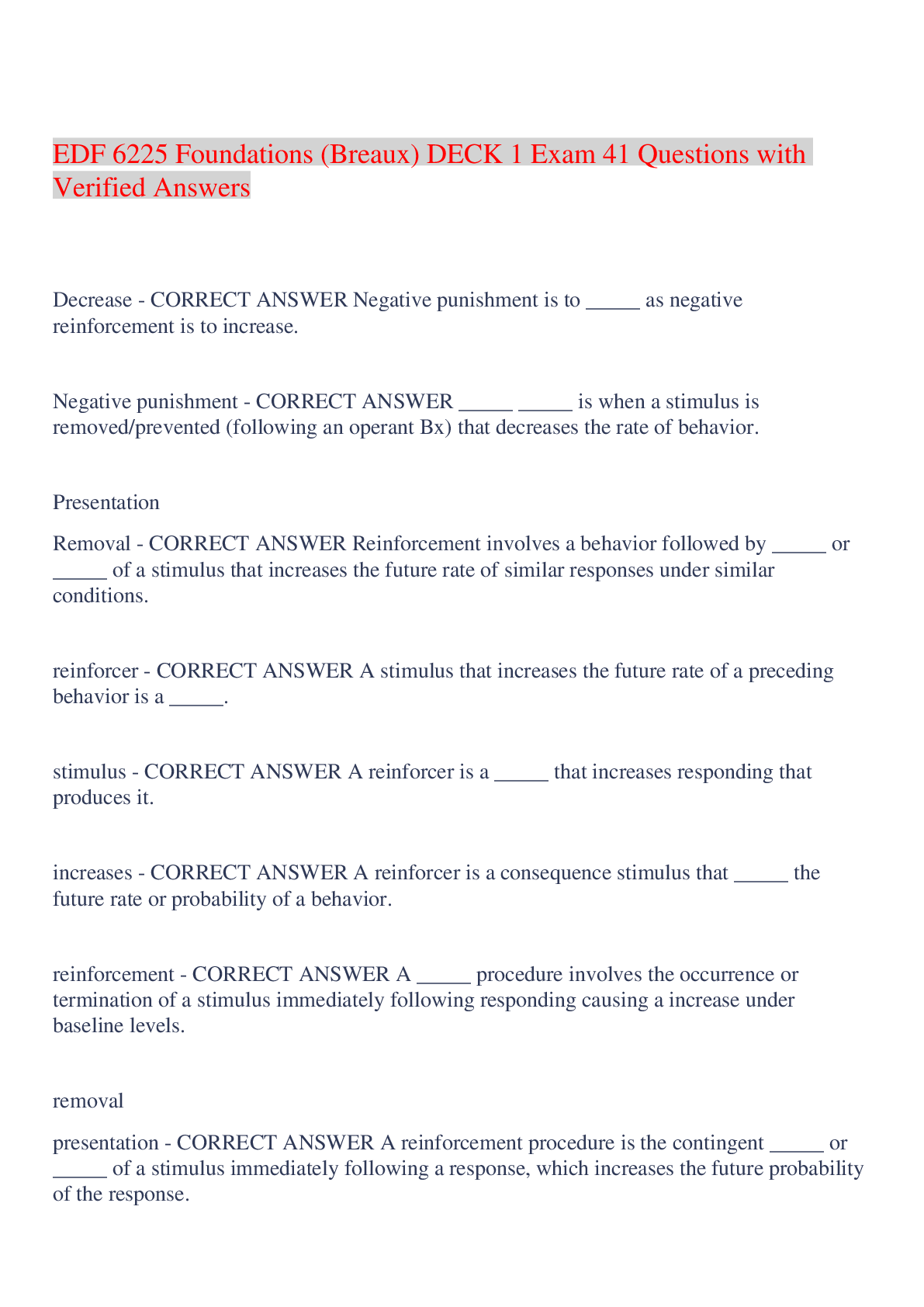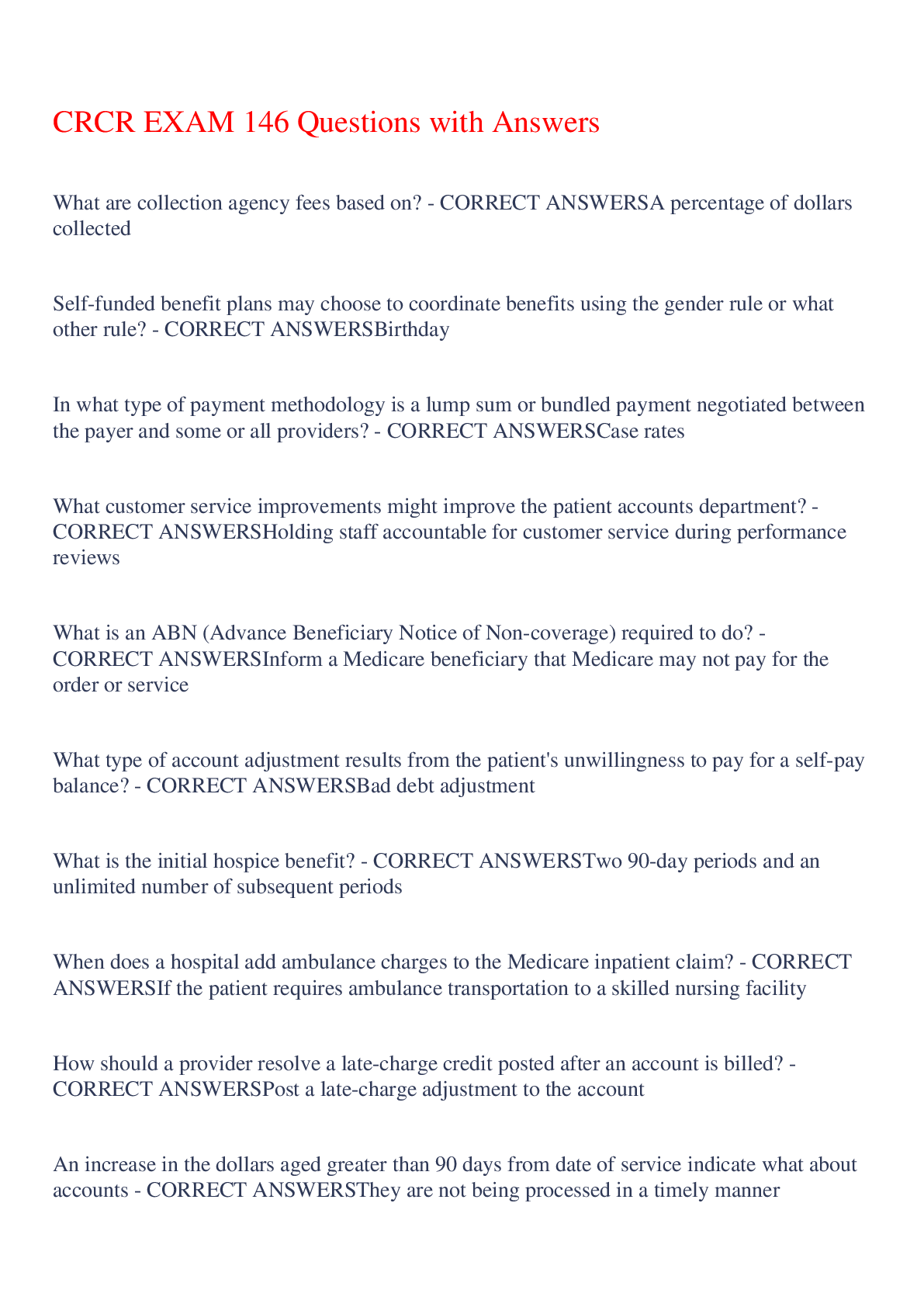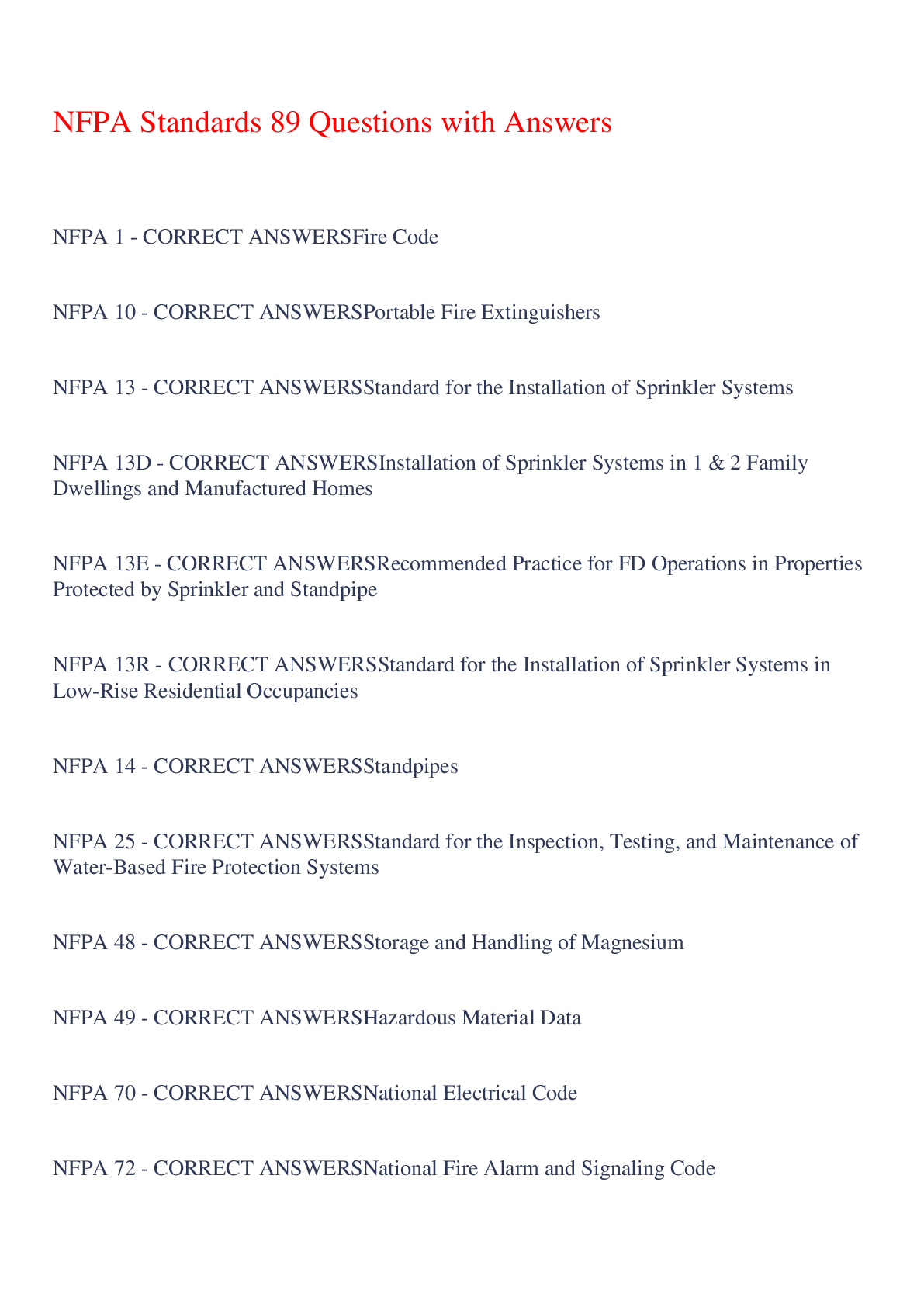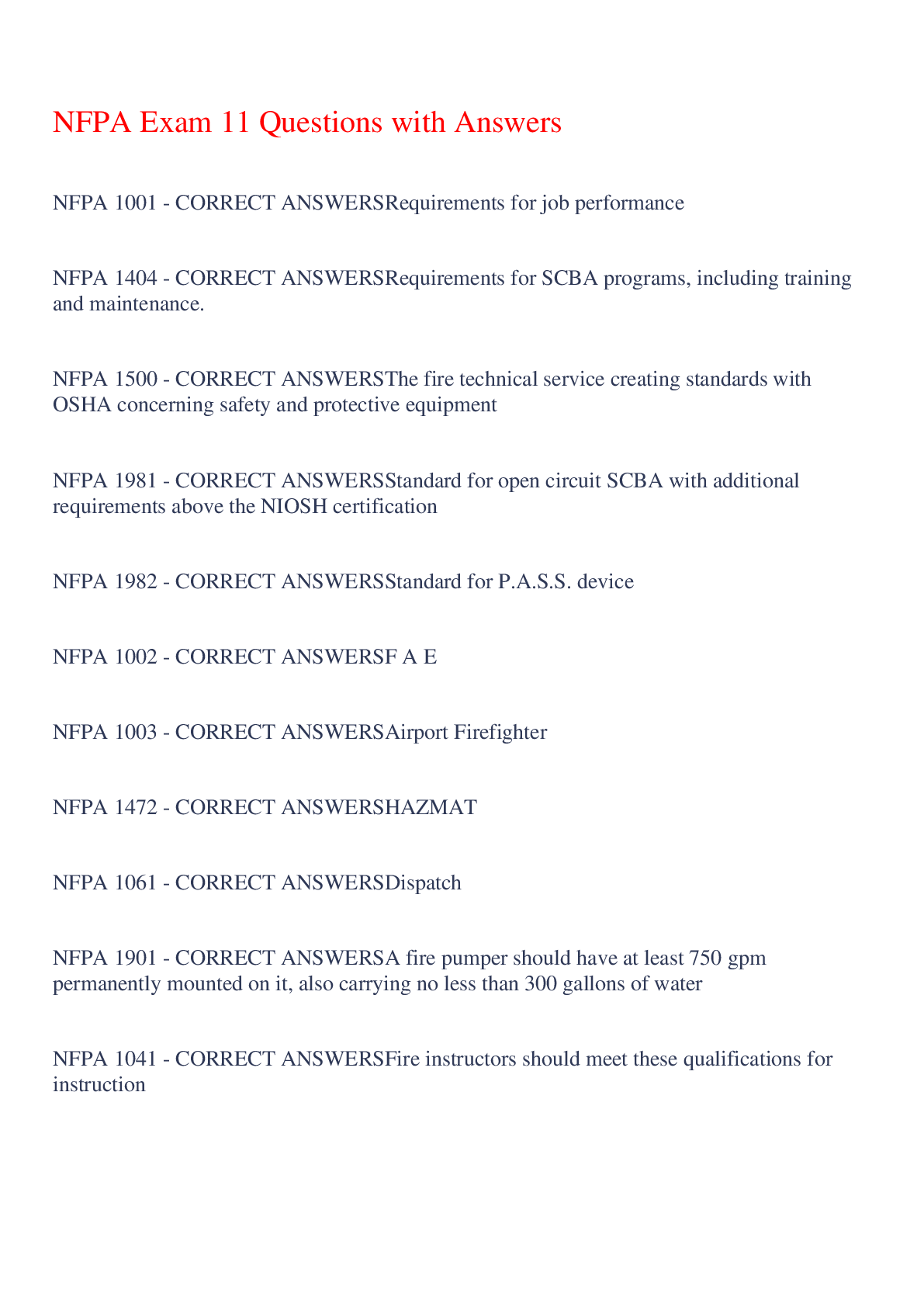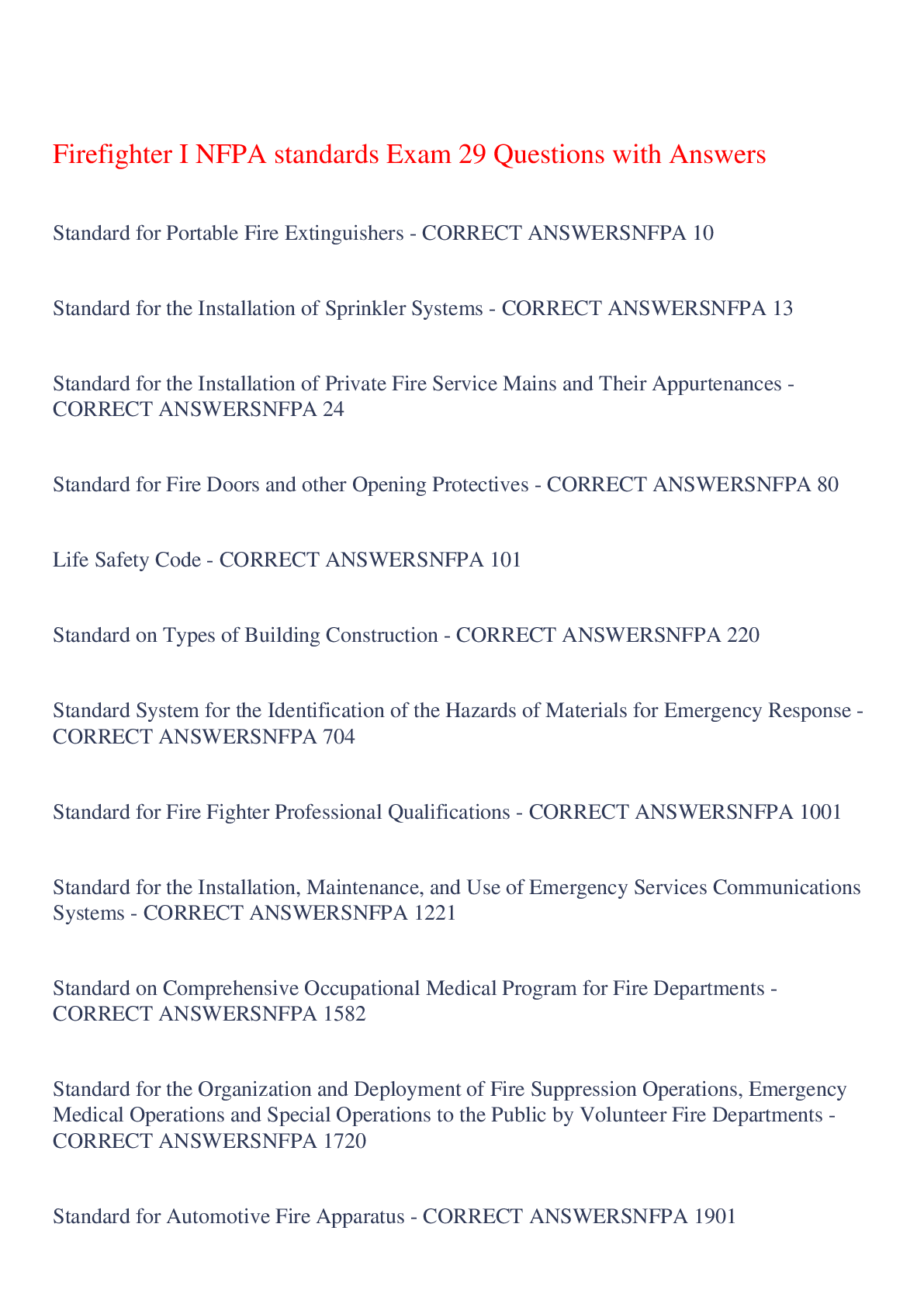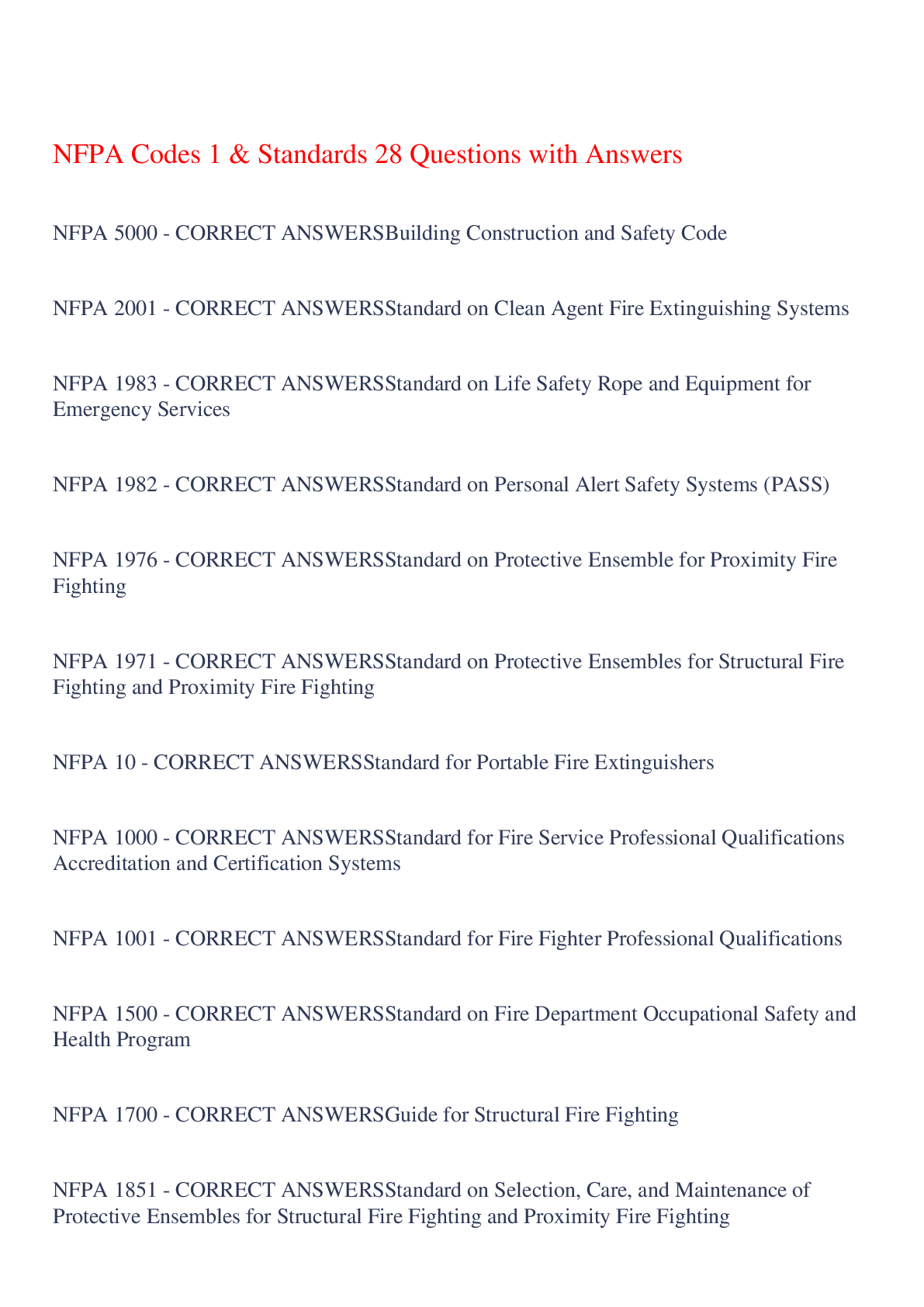Early Childhood Development Exam 80 Questions with Answers,100% CORRECT
Document Content and Description Below
Early Childhood Development Exam 80 Questions with Answers Development - CORRECT ANSWER The process by which humans change both qualitatively and quantitatively as they grow older. early childhoo... d development - CORRECT ANSWER the development of children from conception and birth through age 8. Collective Families - CORRECT ANSWER families that are more likely to collaborate in daily life,pooling resources, sharing household tasks and child-rearing responsibilities making group decisions, and banding together in the face of adversity. Firm and Directive socialization practices - CORRECT ANSWER techniques of child guidance, more common in families of traditionally oppressed cultures, in which behavior is closely monitored and regulated in order to keep children safe from danger. Valuing/Devaluing Western Education - CORRECT ANSWER responses of cultural groups to the mainstream educational system. in some cultures education is viewed as a way to better oneself; in others children are encouraged to reject mainstream educational institutions. Unique/diverse needs - CORRECT ANSWER the distinct needs of each individual child that are not related to background or disability. special needs - CORRECT ANSWER the needs of children that result from developmental delays or disabilities. cultural/ethnic diversity - CORRECT ANSWER variations in development and behavior that are due to a child's cultural background. socioeconomic status - CORRECT ANSWER SES a measure of a family's overall economic and social status, determined by level of education, income,place of residence, and occupation of primary wage earners. evidence-based practice - CORRECT ANSWER the use of teaching and caregiving strategies that research studies have been found to be effective in promoting development. normative charts - CORRECT ANSWER graphic representations of the stages or milestones children pass through as they develop. correlational study - CORRECT ANSWER a type of research in which two traits are measured and their relationship is examined. cross-sectional study - CORRECT ANSWER research in which a trait is studied by examining children of many different ages at one time, and developmental trends are determined by comparing one age group to another. longitudinal study - CORRECT ANSWER research in which a group of children is studied over a long period of time to observe changes in behavior and development at various ages. experimental study - CORRECT ANSWER research in which a treatment, such as an educational intervention, is administered to subjects. an experimental group receives the treatment, a control group doesn't, and the researcher compares the outcomes of the two groups. quantitative methods - CORRECT ANSWER research methods in which children are observed and their behaviors counted or rated numerically. the numbers that are obtained are then entered into computer programs and analyzed statistically. qualitative research - CORRECT ANSWER research that involves writing a rich description of behaviors and development rather than counting or quantifying observations. ethnography - CORRECT ANSWER a type of research in which investigators spend significant time working or living with group-a classroom, family, or a community- and write qualitative descriptions of their observations. response to intervention - CORRECT ANSWER RTI an educational approach in which professionals assess the needs of all children-not just those with disabilities- and determine the level of support they need at school and at home. summative assessment - CORRECT ANSWER an overall evaluation of children's growth after they have completed a school year or some other long period of learning and teaching. receptive vocabulary - CORRECT ANSWER the number of words a child can understand when listening to another speaker. formative assessment - CORRECT ANSWER the evaluation of children's behavior, learning, and development over time, and relatively frequently, in order to immediately improve services to individual children. developmental checklist - CORRECT ANSWER a classroom observation system in which a teacher or caregiver rates children's attainment of certain developmental milestones, such as resolving conflicts or playing cooperatively with peers. event sampling - CORRECT ANSWER a method of observing children in which a teacher or researcher records the number of times a particular behavior or event occurs. time sampling - CORRECT ANSWER a research method in which a teacher or researcher observes children at regular time intervals and records interactions that occur during that period. anecdotal records - CORRECT ANSWER a qualitative assessment method in which children's behavior is observed and recorded in a rich narrative. work sampling - CORRECT ANSWER a method of formative, qualitative assessment in which examples of children's play and work that reveal things about their development are collected and analyzed over time. phonemic awareness - CORRECT ANSWER the ability to distinguish and identify sounds in spoken language. case studies - CORRECT ANSWER a qualitative assessment method that involves, gathering in depth information on an individual child or family and writing an extensive narrative profiling development. autism - CORRECT ANSWER a condition characterized by a lack of awareness of others, a preference for objects to people and an intense desire for sameness. join attention - CORRECT ANSWER the ability of a child to focus on and interact with the same object or activity as another person. floortime - CORRECT ANSWER a method in which an adult gets on the floor to engage an infant, toddler, or preschooler with special needs in active reciprocal play. theory - CORRECT ANSWER a system of beliefs about something. a child development theory is a collection of beliefs about why children behave, think, and feel as they do. maturationist theory - CORRECT ANSWER a theory that holds that most of what humans become is predetermined by genetics and that traits inherited from ancestors simply unfold as children mature. developmental milestones - CORRECT ANSWER specific characteristics that are expected to emerge in children at various age levels. difficult temperament - CORRECT ANSWER a disposition that is characterized by harsh and negative reactions to new or frustrating situations, irregular patterns of sleeping or eating, and numerous adjustment problems. heritability ratio - CORRECT ANSWER a mathematical estimate of the relative role of genetics in determining intelligence. behaviorist theory - CORRECT ANSWER a theory that holds that most of what humans become is shaped by the environment. classical conditioning - CORRECT ANSWER a strategy for shaping behavior in which a neutral stimulus is paired with a pleasurable one. eventually the subject responds in the same way to the neutral stimulus as to the pleasurable one, even when the pleasurable stimulus is no longer present. operant conditioning - CORRECT ANSWER a form of training in which a desired behavior is immediately rewarded. when this occurs, that behavior is preformed more frequently. social learning theory - CORRECT ANSWER a theory that holds that humans learn new behaviors by imitating the people around them. when they are rewarded for this imitation, they will perform these behaviors more frequently. psychoanalytic theory - CORRECT ANSWER a theory that holds that emotional development is influenced by tensions between internal desires and impulses and the demands of the outside world. the resolution of these tensions is needed to become a healthy adult id - CORRECT ANSWER freud's term for the part of the mind that contains instinctual urges and strives for immediate gratification but is kept in check by the ego and superego. ego - CORRECT ANSWER freud's term for the part of the mind that is rational and regulates and redirects the instinctual impulses of the id. superego - CORRECT ANSWER freud's term for the part of the mind that comprises the conscience including the values and mores of one's culture. trust - CORRECT ANSWER Erickson's term for an emotional state, often acquired in infancy, in which children feel secure and know that basic needs will be met by caregivers. such experiences as child abuse or neglect will lead infants to an opposite state-mistrust of the world and the people in it. autonomy - CORRECT ANSWER Erickson's term for an emotional state, often acquired in toddlerhood, in which children strive to be independent and separate from parents. children who are overly restricted will feel shame and doubt. initiative - CORRECT ANSWER Erickson's term for an emotional state, often acquired in the preschool years , in which children assert themselves, make creative attempts, take risks, and reach out to peers. children whose initiatives are thwarted will experience an opposite emotional state: guilt. industry - CORRECT ANSWER Erickson's term for an emotional state, often acquired in the elementary years, in which children feel competent because of successes in and out of school. repeated failure will result in an opposite emotional state: inferiority. cognitive- developmental theory - CORRECT ANSWER a theory of human development holding that knowledge is actively constructed by the child and that active problem solving, social interaction, and language are necessary for learning. assimilation - CORRECT ANSWER piaget's term for a learning process in which humans integrate new ideas or information into what they already know about. accommodation - CORRECT ANSWER piaget's term for a learning process in which humans modify what they already know to make room for new ideas or information. cognitive development - CORRECT ANSWER mental development, including problem solving and acquisition of knowledge. sensorimotor stage - CORRECT ANSWER piaget's stage of cognitive development that encompasses infancy , in which thinking is limited to using physical action and senses to know about things. pre-operational stage - CORRECT ANSWER piaget's stage of cognitive development that encompasses early childhood, in which children use internal symbols but still rely on perception and physical cues in the environment for learning. concrete operational stage - CORRECT ANSWER piaget's stage of cognitive development that encompasses the elementary years, in which thinking becomes more internal and abstract but in which children still need the support of concrete objects in order to learn. formal operational stage - CORRECT ANSWER piaget's stage of cognitive development that encompasses adolescence and adulthood, in which thinking is purely abstract and not tied to the immediate physical world. social cognition - CORRECT ANSWER the ability to understand social situations, including skill at recognizing the outcomes of ones own behaviors and the actions and motives of others. sociocutural theory - CORRECT ANSWER a theory that holds that thinking and learning are highly influenced by social interaction, language, and culture. nonverbal thought - CORRECT ANSWER an early form of mental activity in which a children observe objects or events or perform actions without using language. non-conceptual speech - CORRECT ANSWER an early form of language in which children utter words or phrases without thinking fully about what they mean. verbal thought - CORRECT ANSWER a kind of thought in which language and thinking are integrated and mutually supportive. Children use language -such as verbal labels and self-directed speech- to guide learning. self-directed speech - CORRECT ANSWER a verbal behavior in which children talk to themselves, naming objects or narrating their actions - particularly as they solve problems. scaffold - CORRECT ANSWER to use language and social interaction to guide children's thinking. zone of proximal development - CORRECT ANSWER a situation in which a problem or task is only slightly above a child's ability level. in this zone adults can ask questions or give hints that allow the child to solve the problem independently (scaffold). information processing theory - CORRECT ANSWER a theory of development that emphasizes how children learn in specific situations, relying on memory, attention, and other learning processes. this theory compares the learning process with the way a computer stores, modifies, and retrieves information. attention - CORRECT ANSWER a mental strategy in which learners consciously control what they focus on, so they concentrate on only one or several of the most relevant phenomena at a time. memory - CORRECT ANSWER events or experiences that are stored in the mind and can later be retrieved. social information processing theory - CORRECT ANSWER an information processing theory that explains how children attend to, interpret, store in memory, and later retrieve the social cues they observe in interactions with others. social cues - CORRECT ANSWER actions,facial expressions, tone of voice, spoken words, and other social signals performed by peers that help young children interpret social situations. ecological systems theory - CORRECT ANSWER a theory of development that emphasizes the influence of the many institutions and settings - the community, school, political system- within which children live. this theory holds that individual development does not occur in a psychological vacuum but is affected by larger society. ecology - CORRECT ANSWER the many different settings or institutions that affect human development. microsystem - CORRECT ANSWER the layer of environmental influences on development that includes all institutions and experiences with the child's immediate environment. the family, the school, and peers are examples. mesosystem - CORRECT ANSWER the layer of environmental influences on development that is composed of the interconnections among the persons or organizations with in the microsystem. Parent-teacher communication and collaborations between child care centers and public schools are examples. exosystem - CORRECT ANSWER the layer of environmental influences on development that is composed of institutions or persons that do not actually touch children's lives but that indirectly affect their experiences. the legal services system or the public assistance office are examples. macrosystem - CORRECT ANSWER the layer of environmental influences on development that is contains the overarching values, ideologies, laws, world-views, and customs of a particular culture or society. a society's respect and caring for children is an example. risk factors - CORRECT ANSWER conditions in a child's life that can lead to poor development, including poverty, community violence, and child abuse. protective factors - CORRECT ANSWER conditions that might insulate children from the negative effects of risk factors. attachment to parents an positive preschools experiences are examples. neuroscience - CORRECT ANSWER a field of study that investigates the structure and mechanisms of the brain and how they affect development. reward center - CORRECT ANSWER an area of the brain that causes individuals to seek pleasurable sensations and to behave in ways that lead to rewards. [Show More]
Last updated: 2 years ago
Preview 1 out of 3 pages
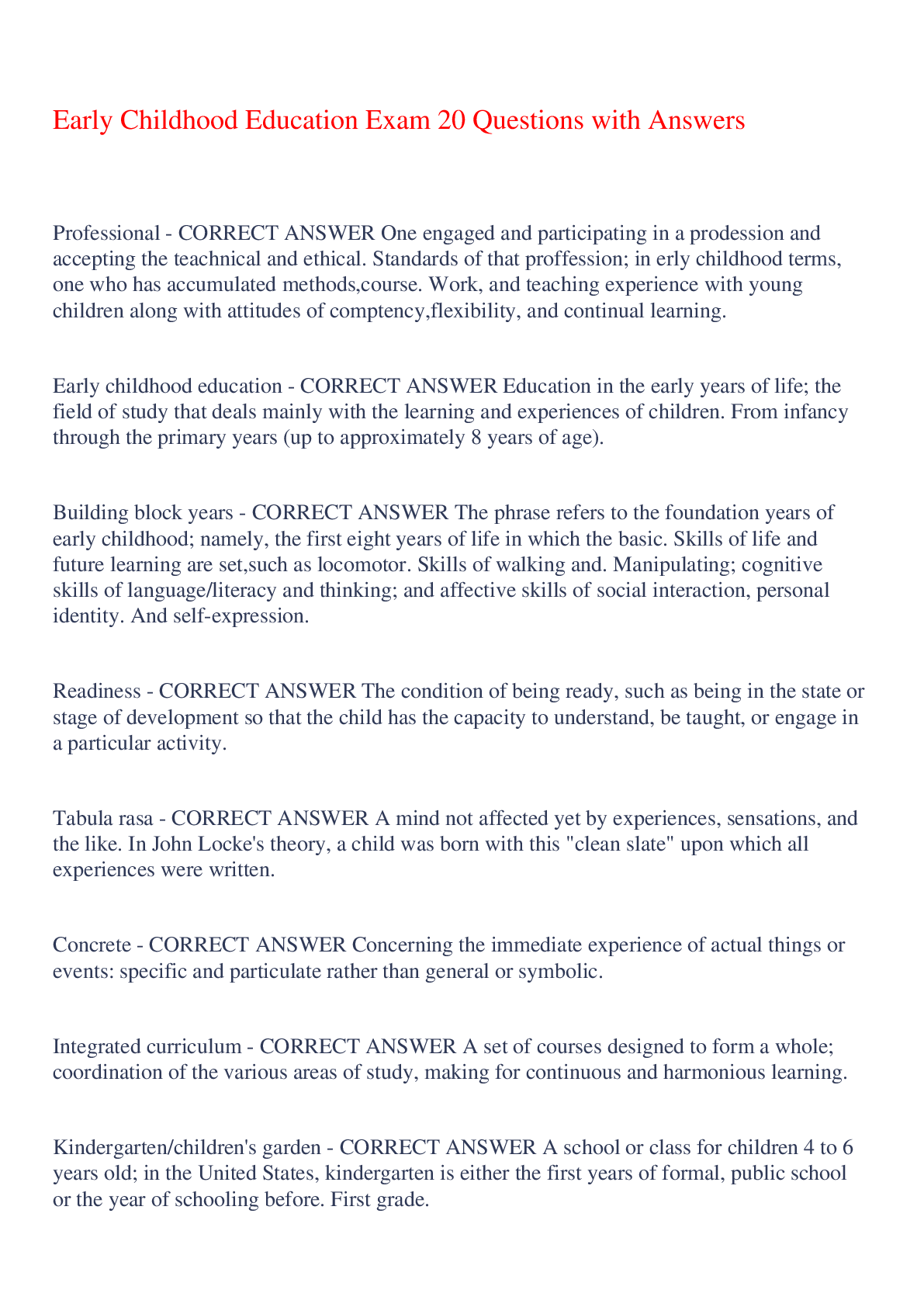
Buy this document to get the full access instantly
Instant Download Access after purchase
Buy NowInstant download
We Accept:

Reviews( 0 )
$6.50
Can't find what you want? Try our AI powered Search
Document information
Connected school, study & course
About the document
Uploaded On
Apr 29, 2023
Number of pages
3
Written in
Additional information
This document has been written for:
Uploaded
Apr 29, 2023
Downloads
0
Views
93


